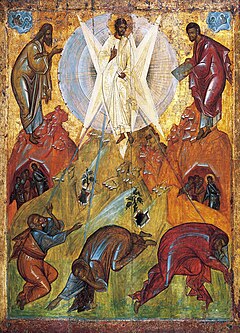| The Transfiguration of the Lord | |
|---|---|
 Icon of the Transfiguration by Theophanes the Greek, 15th century | |
| Observed by | Christians |
| Significance | Transfiguration of Jesus |
| Date | 6 August |
| Frequency | Annual |
The Feast of the Transfiguration is celebrated by various Christian communities in honor of the transfiguration of Jesus. The origins of the feast are less than certain and may have derived from the dedication of three basilicas on Mount Tabor.[1] The feast was present in various forms by the 9th century, and in the Western Church was made a universal feast celebrated on 6 August by Pope Callixtus III to commemorate the raising of the siege of Belgrade (1456).[2]
In the Syriac Orthodox, Malankara Orthodox, Revised Julian calendars within Eastern Orthodoxy, Catholic, Old Catholic, and Anglican churches, the Feast of the Transfiguration is observed on 6 August. In the Armenian Apostolic Church, the Feast of the Transfiguration is observed on the fourteenth Sunday after Easter.[3] In some Lutheran traditions preceding the reforms to the liturgy in the 1970s, 6 August was also observed as the Feast of the Transfiguration. In those Orthodox churches which continue to follow the Julian Calendar, 6 August falls on 19 August of the Gregorian Calendar. The Transfiguration is considered a major feast, numbered among the twelve Great Feasts in Byzantine Catholicism and Orthodoxy. In all these churches, if the feast falls on a Sunday, its liturgy is not combined with the Sunday liturgy, but completely replaces it.
The transfiguration can also be remembered at other points in the liturgical year, sometimes in addition to the feast itself. In the ancient western lectionary, the Ember Saturday in Lent included the gospel of the Transfiguration. In the Catholic lectionary, on the second Sunday in Lent the gospel of the Transfiguration is read. In the Revised Common Lectionary, followed by some Lutherans, United Methodists, Anglicans, and others, the last Sunday in the Epiphany season (that immediately preceding Ash Wednesday) uses the gospel account, which has led some churches without established festal calendars to refer to this day as "Transfiguration Sunday". In the Church of Sweden and the Church of Finland, the story is read on the seventh Sunday after Trinity, the eighth Sunday after Pentecost.
- ^ Festival icons for the Christian year by John Baggley 2000 ISBN 0-264-67487-1 pages 58–60
- ^ Christian liturgy by Ignatius Puthiadam 2003 ISBN 81-7109-585-2 page 169
- ^ "Feast of the Transfiguration".